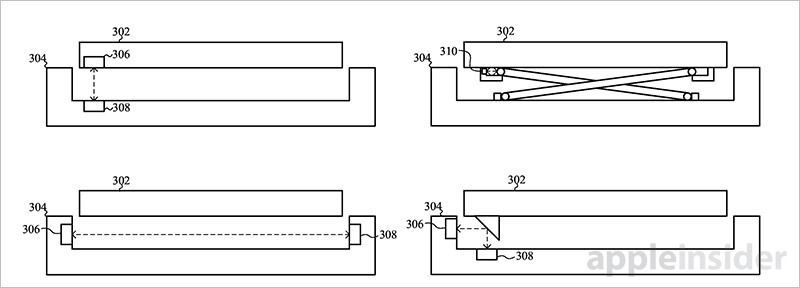An Apple invention detailed in a patent application published Thursday describes a method of decoupling a keyboard's mechanical feel from its electrical functionality using proximity sensors, which allows greater customize key feedback.
At its heart, Apple's patent application for "Depressible keys with decoupled electrical and mechanical functionality," published by the U.S. Patent and Trademark Office, details a computer keyboard that replaces common
Contemporary keyboards rely on electromechanical actuators to transmit key press signals to a central processing unit. The components usually incorporate multiple structures under a single keycap, for example a key travel mechanism (butterfly or dome switch), tactile feedback structure (membrane) and electrical contacts or electrodes.
Due to tight space constraints in modern keyboards, especially laptop versions, the tactile feedback component is often nested within the key travel mechanism below the electrical traces. The parts sandwich inhibits independent component modification, as a manufacturer must rework the entire system to achieve different keyboard experiences.
Users, meanwhile, have divergent tastes when it comes to a tactile feedback, as some prefer a silent, low travel key press, while others like loud "clackity clack" keys with long throws. Keyboard "feel" is hotly debated when Apple launches a new MacBook, for example.
To better cater to individual user preferences, Apple proposes a method for decoupling the mechanical and tactile functionality of a key from its electrical functionality. Specifically, the document replaces electrical contacts and traces with non-contact proximity sensors, while travel mechanism and feedback structures remain largely intact.
In most embodiments, Apple's key design features a light emitter aimed at the reflective bottom surface of a keycap. An accompanying light detector, or central detector connected to a light guide, generates an electrical signal in response to the received light. When processed by a keyboard controller, the signals can be used to estimate force, velocity and distance metrics to accurately determine when a key is pressed.
The resulting data set is much wider than simple "open or closed" circuit constraints seen on traditional keyboards. By applying pre-determined thresholds to incoming signals, Apple's invention can in some cases detect errant key presses and support force-sensitive input applications.
Other embodiments include dynamic threshold adjustments on a per-key and per-application basis, allowing users to set one input level for word processing and another for gaming.
As for tactile feedback, Apple's invention includes contingencies for installing structures formed from a materials capable of elastic deformation such as an electroactive polymer or shape-memory metal. In some embodiments, users can adjust the feel of these components on the fly.
Apple's document goes on to describe alternative embodiments and a detailed rundown of how the optical sensor mechanism functions. The company also mentions manufacturing benefits of deploying a decoupled keyboard system.
It is unclear whether Apple intends to implement its customizable keyboard in a future Mac product. The company is, however, expected to announce new Mac hardware at a special event next week.
Apple's patent application for a keyboard with decoupled electrical and mechanical functionality was first filed for in April 2015 and credits Chang Zhang, Dayu Qu, Ray L. Chang and John S. Camp as its inventors.
 Mikey Campbell
Mikey Campbell









-m.jpg)






 Andrew Orr
Andrew Orr
 Amber Neely
Amber Neely
 Marko Zivkovic
Marko Zivkovic
 William Gallagher and Mike Wuerthele
William Gallagher and Mike Wuerthele



 Mike Wuerthele
Mike Wuerthele









10 Comments
I realize Apple is seeking to advance Keyboard Technology, improve the User Experience, etc. . . . but I have a 12"MacBook8,1. Perfect in almost every way except the New Keyboard. It is a fraction of an inch different from my 13" MacBook Air. The key height is lower on the MacBook8,1. As a long time user of computers, 40+, I don't like at all the smaller keyboard. The MacBook Air Keyboard is much better. I get almost a 95% "correct" key pressed rate. The MacBook 8,1 with the new style keyboard is a problem for me. So much of a problem, I am selling it and getting a larger laptop. All said , there is still room for improvement in the new keyboard. It will not be long before the LED Keyboard is completely customizable. Or at least you will be able to see the other keys available when you press a function key. I still look for the special characters and would love to see them on the actual keyboard.
If this invention is coupled with haptic feedback, then I could see the point, since a variable feel keyboard would be a useful goal. For those having trouble with the current MacBook keyboard, is the key spacing the same as on the MacBook Air? I find it hard to imagine that vertical travel would be a major issue for keyboard accuracy; but personal experience shows that key spacing has a dramatic impact on accuracy.
LED keyboard would be interesting as it would easily allow people who wanted to do things like run alternate keyboards (Dvorak, etc) to switch as desired.
This could potentially be helpful for waterproofing the MacBook line as well.
Removing the interactive feel of the keyboard seems like a step in the wrong direction.